In which direction is Japanese written and read? Is it left to right, top to bottom like English? Or is it something else?
The answer is both, actually. On the internet, Japanese is written horizontally, left to right, top to bottom, just like English. Traditionally, however, Japanese is written vertically, top to bottom, then right to left, which from an English perspective makes it look like it goes backwards (from right to left). Lastly, there are also rare cases when it looks like Japanese is written horizontally but backwards.
Japanese Vertical Writing
Japanese is traditionally written vertically, top to bottom, then right to left. This "vertical writing," tategaki 縦書き, is used in books, novels, light novels, manga, and so on.
See rendaku 連濁 for why kaki is read ~gaki.
This direction also affects the layout of certain things.
Japanese comics are read starting from the top-right panel and ending in the bottom-left panel, and they're read "backwards," that is, you start a manga at the last page, or rather, at the rightmost page, and go toward the left to the first page.
Exceptionally, a single page of yonkoma よんコマ, "four panel" comics, may contain two separate strips that look like eight panels in four rows, but are actually eight panels in two columns. The right column is read first, then the left one.
Some applications also follow this pattern. A "next" or "forward" arrow may be a left arrow in a Japanese website, for example.
Manga: One Punch Man, ワンパンマン (Chapter 1)
- Context: two screenshots of an online manga reader with an user-interface that is counter-intuitive for native English speakers.
- The progress bar shows on the left that the chapter has 28 pages.
- The purple handle displays the current page, 4 and 5, respectively. Note that these are at the start of the chapter, but the handle is toward the right side of the bar. It goes more to the left as you progress.
- On the bottom-left there is a link for the next chapter, with an arrow pointing to the left.
The difference between the Japanese writing direction and the English one is also seen in how scrolls are depicted in stories. A scroll in an European medieval fantasy setting is unrolls vertically, the reader opens it pulling one side down or up. An ancient Chinese or Japanese scroll opens horizontally. In both cases, when writing the scroll, the shorter side determines the length of a single line: if a scroll is wide, it isn't written horizontally, but vertically, so lines can't be longer than the scroll's height, and if it's a tall scroll, it isn't written vertically, but horizontally, so lines can't be longer than its width.
In Japan, the family name (last name) comes before the given name (first name). If a character is called Ayasaki Hayate, then his name is Hayate, and Ayasaki is his family.
Due to the last name coming first, and what is written first being written above what is written last, there are two terms for "family name" and "given name" that refer to their positions in writing instead:
- ue no namae
上の名前
Name of above. Top name. (literally.)
When writing one's full name, the name on that comes first, at the top.
The family name. Surname. Last name. - shita no namae
下の名前
Name of below. Bottom name. (literally.)
When writing one's full name, the name that comes last, at the bottom.
The given name. First name.- shita no namae de yonde-hoshii
下の名前で呼んでほしい
[I] want [you] to call [me] by [my] first name. - See also: up, down, left right.
- shita no namae de yonde-hoshii
Japanese was originally written vertically, like Chinese, and only started being written horizontally after contact with the west. For example, a certain 19th century Japanese-English dictionary (袖珍挿図独和辞書) wrote it horizontally so it wasn't necessary to turn the book by 90 degrees to read the translations.(ja.wikipedia.org)
As consequence, vertical text is generally more traditional, while horizontal text is generally more modern.
For example, anything that is written using calligraphy, shodou 書道, like poems, will be written vertically. Due to many idioms having four characters (yojijukugo 四字熟語), it isn't unusual to see four-character slogans written in this orientation.
Receiver: Jahy, ジャヒー
Anime: Jahy-sama wa Kujikenai!, ジャヒー様はくじけない! (Episode 1, Stitch)
- Context: the text on Jahy's shirt reads makai fukkou 魔界復興, "demon-world reconstruction," due to the series taking place after the demon world was destroyed.
- See also: Cobra Twist (Wrestling Hold).
English Text in Japanese Vertical Writing
There are three ways English words may be written in a vertical text layout:
- One character above the other.
- The whole text rotated 90 degrees.
- With very short English words, like two-letter abbreviations, horizontally occupying a single space.
Some examples:
- Context: Masa 雅 asks Tatsu たつ for help in a fight, who responds:
- jibun de utta kenka yaro
自分で売った喧嘩やろ
That's a fight [you] picked yourself, [wasn't it]!- kenka wo uru
喧嘩を売る
To sell a fight. (literally.)
To pick a fight with someone.
- kenka wo uru
- {jibun de kata-tsuke-n}-no ga suji chau-n-ka!
自分で片つけんのが筋ちゃうんか!
{To clear [your mess] yourself} [is only logical], [am I wrong]?- kata-tsuke-n-no - contraction of kata-tsukeru no 片つけるの.
- suji - reason, logic, besides other meanings, can be used to refer to something that you're supposed or expected to do in response to something else because it's the reasonable thing.
- chau-n-ka - contraction of chau no ka.
- chau - Kansai dialect, equivalent to chigau 違う, "to differ," "to be wrong about something."
- Do it yourself!!
Do it yourself!!
- Context: several examples of peculiar furigana usage (gikun 義訓) excerpted from the first chapter of Overlord.
- "Yggdrasil" is written with characters one above the other.
- "Non Player Character" is written rotated.
- "NPC" and "POP" in the furigana are written with characters on above the other.
Horizontal Text in a Vertical Line in Japanese
For reference, some examples of short texts written horizontally within otherwise vertical lines:
- Context: characters are asked what's their favorite hero, Mineta Minoru 峰田実 answers:
- oira wa (maunto) Mt. Redhi!!
オイラはMt.レディ!!
For me, [it's] Mt. Lady!!
- Context: Dr. Tenma is greeted by someone whom he doesn't recognize.
- yaa, dokutaa Tenma......
やあ、Dr.テンマ・・・・・・
Hey, Doctor Tenma...... - ano......
あの・・・・・・
Erm...... - sumimasen, donata deshita kke......
すみません、どなたでしたっけ・・・・・・
Sorry, who are you, again.......
- Context: Jahy-sama works as a waitress.
- oneechan, kocchi mo nama-chuu futatsu ne
おねーちゃん こっちも生中2つね
Missy, two beers here, too.- nama-chuu - from nama-biiru 生ビール, "raw beer," as in "draft beer," in a a jug of "medium," chuu 中, size.
- oneechan - literally "older sister," may also refer to a young woman casually, "missy."
- gaya gaya
ガヤガヤ
*noisy crowd.* - oneechan!? ki-yasuku yobi-otte! ware wo dare da to omotte-iru
おねーちゃん!?気やすく呼びおって!我を誰だとおもっている
Missy?! Calling [me] so casually! Who does [he] think I am?- ki-yasui - relaxed, familiar, casual, as opposed to formal.
- yobi-otte - te-form of yobi-oru 呼びおる.
- ~oru suffixed to the ren'youkei 連用形 of a verb works similarly to ~yagaru ~やがる, used to say someone "dares" to do something to you, expressing angers or amazement.
- nama-chuu futatsu na
生中2つな
Two beers, right? - pi, pi
ピピ
*writing down.* - ware wa makai nanbaa tsuu no Jahii-sa...
我は魔界No.2のジャヒーさ・・・
I['m] the demon world's number two, Jahy-sa...
- Here, Jahy was about to call herself Jahy-sama. You don't normally use honorific suffixes toward yourself, specially the respectful ~sama ~様, as it sounds pompous. This is typically done by characters that are extremely proud, over-confident, or bossy.
- nanbaa tsuu, the katakanization of "number two," was used as furigana for its abbreviation.
- neechan, kocchi mo~
ねーちゃんこっちもー
Missy, here too~ - a'!? hai!
あっ!?はい!
Ah? [One second]!- hai - "yes," used as an affirmative response in general.
Horizontal Parentheses in Japanese Vertical Text
Sometimes, a short text within parentheses is exceptionally written horizontally in vertical writing.
Anime: Morita-san wa Mukuchi 森田さんは無口 (Episode 1)
- Context: Morita Mayu's name is written vertically. The number 16 in parentheses is written horizontally after it. In Japanese, a number in parentheses after a person's name means their age, so Mayu is 16 years old.
- Context: characters from Gintama do odd jobs. Someone left a monstrously huge dog outside their home, with a letter that said "please take care of my pet."
- ......... sore dake ka?
・・・・・・・・・それだけか?
.........only that? (that's all that is written?) - kakko-warai to kaite-arimasu
(笑)と書いてあります
(laugh) is [also] written. (literally.) - waraeru kaaaaaaa!! kakko ikari kakko-toji
笑えるかァァァァァァ!!(怒)
[How] can [I] laugh!! (anger)- waraeru - potential verb from warau 笑う, "to laugh."
- See also: tsukkomi ツッコミ.
- Although the manga makes no distinction, in the anime adaptation (10th episode), Shinpachi 新八 pronounces (笑) as kakko warai, without kakko-toji 括弧閉じ, "close [round] bracket," while Gintoki 銀時 pronounces (怒) as kakko ikari kakko-toji.
- uwa'!!
うわっ!!
Tables, Columns & Rows in Japanese Vertical Writing
In vertical writing, the columns of a table are horizontal and start at the right side, while the rows are vertical, which may be shocking since it's literally the opposite of how it works in English, but at the same time it makes perfect sense if you think about it.
- Context: part of a gojuuon 五十音, "fifty sounds" layout, used to display the kana 仮名 characters.
Japanese Horizontal Writing
Japanese is written horizontally sometimes, in the same way as English: left to right, top to bottom. The "horizontal writing," yokogaki 横書き, is specially used in digital text. There are also many case in which horizontal and vertical written are mixed together.
Comics and novels are normally written vertically, but titles may be written horizontally.
- Context: the cover of Lulumate ルルメイト has its title written horizontally.
- See also: electric outlet-shaped eyes.
Books and school textbooks tend to be horizontal text. Textbooks about the Japanese language (national language textbooks) are usually written in vertical text instead.
Software uses horizontal text, simply due to the lack of support for the vertical layout. Any forms with OK and Cancel buttons are going to be horizontal. Games and visual novels also tend to be horizontal.
- Context: an old video game.
- *"ijimenaide kure yo~.
boku wa warui suraimu janai yo.
*「いじめないでくれよー。
ボクは わるいスライムじゃないよ。
pls no bully,
I'm not a bad slime.
- Context: a gojuuon layout for the player to input their name when starting a new game. Observe that although the columns are horizontal, the table is actually left-to-right, which means it follows how text is written horizontally, rather than vertically.
Rare exceptions are text-editing and design software like Microsoft Word, Adobe Photoshop, Clip Studio Paint, and so on.
Websites use horizontal text. This includes Niconico, 2chan, Pixiv, etc. Like software in general, web browsers have historically lacked support for displaying vertical text.
Anime: Zombieland Saga: Revenge (Episode 6)
- Context: a random social media user comments on the legendary Yamada Tae, who is also known by the pseudonym "number 0," zero-gou 0号.
- See also: overly long sleeves.
- zero-gou kami-kawa!!!!!!!
0号神かわ!!!!!!!
Number 0 is super cute!!!!!!!
- Context: a job-search internet ad in Japanese that became a meme.
- uwa'... watashi no nenshuu, hiku-sugi...?
うわっ・・・私の年収、低すぎ・・・?
Yikes... my salary, is too low...?
Nowadays, as of 2021, in modern browsers (i.e. not Internet Explorer), it's possible to make text get displayed vertically through the CSS property writing-mode. For example:
ちはやぶる
神代も聞かず
竜田川
からくれなゐに
水くくるとは
- Context: if your browser supports it, the chihayaburu ちはやぶる poem above should be rendered vertically, and you should be able to select it like any other text.
Ironically, in spite of the great efforts made for the web to finally become able to display Japanese text in its traditional vertical direction, it's unlikely that Japanese websites will adopt it, as internet users are simply used already to using Japanese horizontally.
For example, the famous story website Narou (syosetu.com), on which many isekai stories that somehow got anime adaptations were originally posted, uses the horizontal direction for all its stories, like any other website. That's just how you read Japanese text on the internet.
Some traditional banners and signs of stores feature vertical writing, although horizontal writing is also quite common.
Magazines and newspapers tend to have a mix of horizontal and vertical. The graphics text on covers of books, manga, movies and other products also feature mixed styles. Sometimes one, sometimes the other, sometimes both.
- Context: the cover of a magazine featuring a manba gyaru peace sign.
- Context: an ad for Nihongo Gokan no Jiten 日本語語感の辞典, "Japanese nuance dictionary," depicting various apologetic gestures, the last (leftmost) one being the dogeza 土下座. The text aren't terms for the gestures, but words related to apology.
The same applies to TV broadcasting.
- Context: in a world where carnivores and herbivores are people.
- See also: kemono ケモノ.
- mimei no shokusatsu jiken, han'nin tousou-chuu
未明の喰殺事件、犯人逃走中
Early morning [devouring] incident, perpetrator on the run.- shokusatsu
喰殺
To kill by eating. To devour.
- shokusatsu
Image source: http://f.hatena.ne.jp/lowracer/20051021213334, accessed 2021-08-03.
- Context: a TV program explains what is zettai ryouiki 絶対領域, "absolute territory."
Japanese Written Backwards Horizontally
Japanese can also be written horizontally, but backwards: right to left. This direction was more common in the past, before the second world war, but has largely fallen out of use. You can still find instances of it, specially in period stories.
- Context: this series that takes place in the Meiji 明治 era (1868–1912).
- akabeko
赤べこ
The name of the establishment.
It only occurs with text that has only one single line—labels, signs—never with multi-line paragraphs.
This happens because this "horizontal" direction is actually someone writing vertically, top-down, right to left, but there's only space for one character per line, so it looks like it's written horizontally. It's sometimes called:(ja.wikipedia.org)
- ichi-gyou ichi-moji no tategaki
一行一文字の縦書き
One-row-one-character vertical-writing.
Vertical writing that uses one character per row.
Anime: Jashin-chan Dropkick', 邪神ちゃんドロップキック’ (Season 2) (Episode 2)
- Context: Medusa suddenly starts talking like she's doing a TV ad for some product.
- makai-juu minna de makai-shiki senrigan doroppusu
魔界中みんなで魔界式千里眼ドロップス
[Let's eat] demon-world-style clairvoyance drops with everyone in the demon world.
- Or, maybe, it says:
- supurrodo ganrisen makai-shiki
スプッロド眼里千魔界式
Sprod eye... uh... something thousand... demon-world-style. - This makes no sense, so it's clearly right-to-left.
- The fact that the drops use a right-to-left label implies it's some old, or old-fashioned, product, which is very likely considering characters from the demon world are thousands of years old.
- Context: the Kaminarimon 雷門, "thunder gate," as written vertically in a huge red bamboo lantern. It leads to a temple called Sensouji 浅草寺. The text above the lantern is read horizontally right-to-left: Kinryuuzan 金龍山, "golden dragon mountain." This another name for the Sensouji, as there is a practice of giving mountain names to temples.
Note that, unlike English, Japanese doesn't use spaces to separate words, relying on grammatical and orthographic cues instead to figure out where a word starts and ends.
Text may wrap mid-words without hyphenation or anything of sort. However, it's still preferred to wrap lines at certain points, like after particles or verbs.
Right-to-left text stopped being used after the war, however, when it was in use, before the war, it wasn't the only way to write Japanese horizontally. People also wrote it left-to-right, which sounds extremely confusing if you think about it.
Books with English text, like dictionaries, would use the left-to-right direction like English, while one-line signs, titles, and so on would use the right-to-left direction.
Are There Characters Written Differently Horizontally Compared to Vertically?
There are a few characters are are written differently horizontally and vertically in modern Japanese.
The furigana ふりがな, also known as ruby text, is written at the right side of characters in vertical text, but above characters in horizontal text.
The bouten 傍点, emphasis dots written on the furigana space, also follow this rule.
- Context: in a series about people that have powers called quirks, a doctor examines Midoriya Izuku 緑谷出久, talks about how quirkless people have two joints in his pinky toe, and then says:
- Izuku-kun niwa kansetsu ga futatsu aru
出久くんには関節が2つある
Izuku-kun has two joints.
- The dots on the right side of the phrase 関節が2つ indicate emphasis. Observe that they stack with the reading aid, creating two "furigana layers." If this text was horizontal, and the furigana above, they would stack on top of each other in the same order.
- {kono sedai ja mezurashii...} {nan'no "kosei" mo yadottenai} kata da yo
この世代じゃ珍しい・・・何の“個性”も宿ってない型だよ
A type {rare in this age}, [that] {doesn't [contain] any quirk}.- yadoru
宿る
To dwell. (in this case, for a quirk to dwell in his body, i.e. for a quirk to be contained in him, for him to contain a quirk.)
- yadoru
While horizontal text is underlined, vertical text is sidelined on the right side, which is also the furigana side. The "sideline" is called bousen 傍線.
The prolonged sound mark (ー) is a horizontal dash horizontally, but a vertical dash vertically. Sometimes a it's rendered in a wavy shape, like a tilde (~), which, too, becomes a vertical tilde in vertical writing.
- baaaaakka janee no!?
ば~~~~っかじゃねぇの!?
Aren't [you] stuuuuuupid?- nee ねぇ - contraction of nai ない.
The kanji for the numbers "one, two, three," ichi, ni, san 一二三, appear similar to the prolonged sound mark horizontally, since they're horizontal dashes, however, they don't become vertical in vertical writing.
- Context: in order to become a mangaka, you must first have your manga read by a professional editor. And after he reads it, he may say:
- mou ichido yomasete morau ne
もう一度読ませてもらうね
[I'll] have [you] let me read it one more time, okay?- I'll read it again. (said politely.)
- o'
おっ
Ooh!
The quotation marks 「」『』 are rotated 90 degrees clockwise in vertical text.
The iteration marks called ku-no-ji-ten くの字点 are supposed to be one tall ku く-shaped symbol in vertical writing. In horizontal writing, it looks like a he へ instead.
- 〳〵, or, alternatively:
- /\.
Wordplay
It's possible for writing direction to be used in wordplay. For example, kanji characters are sometimes composed of other kanji characters laid out side by side horizontally or vertically. Changing the writing direction may make the kanji components appear to be separate kanji on their own, or vice-versa.
References
- 縦書きと横書き - ja.wikipedia.org, accessed 2021-08-01.

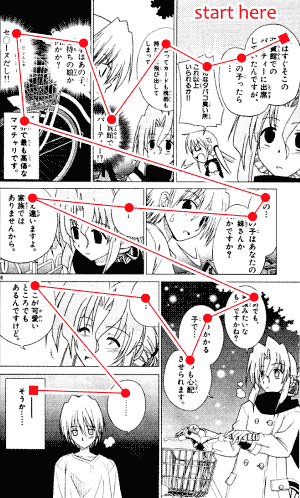

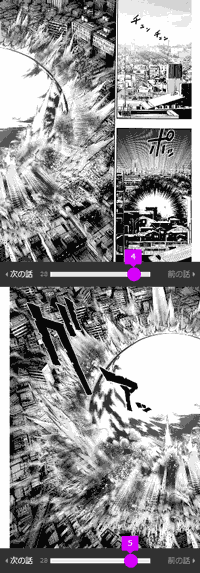
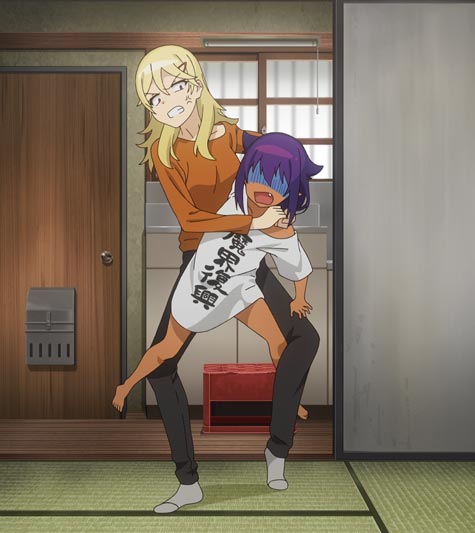
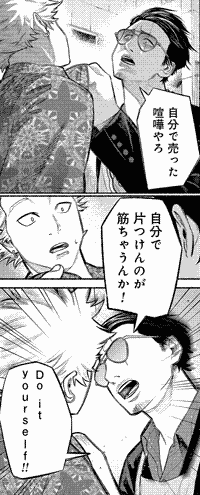
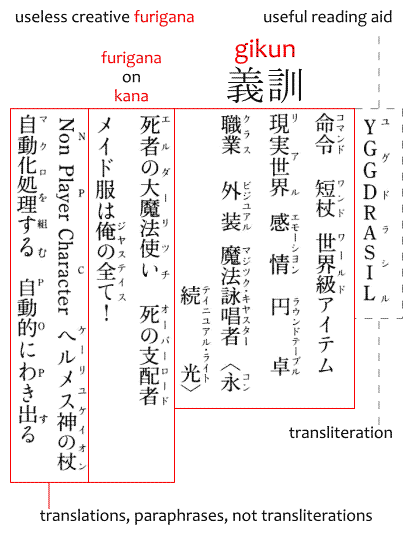
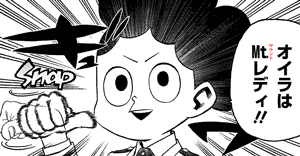
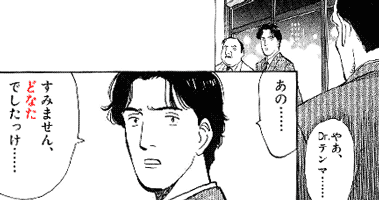

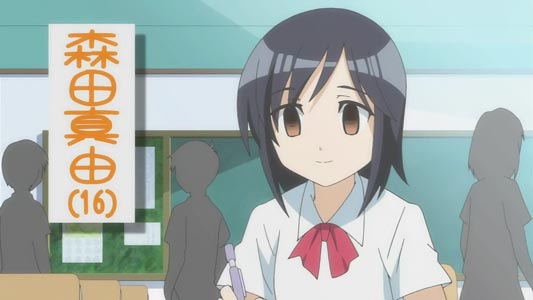

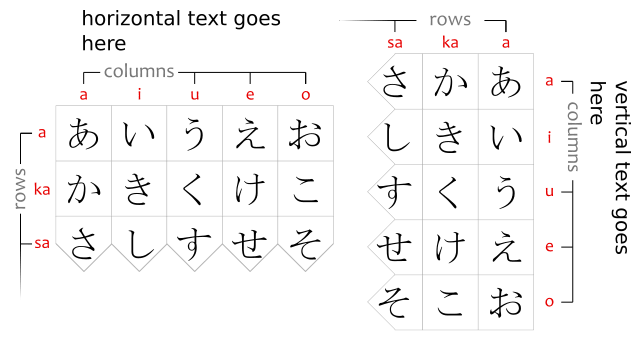
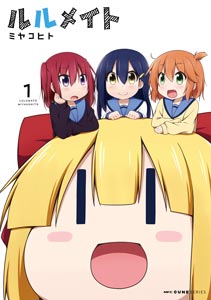
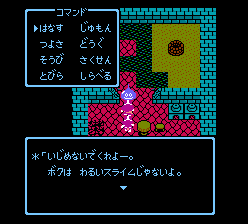
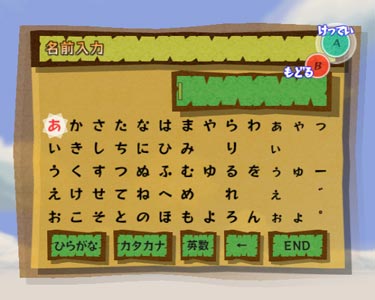
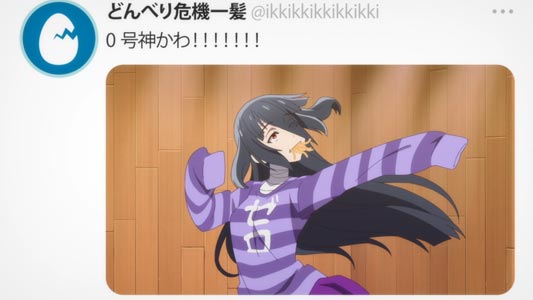
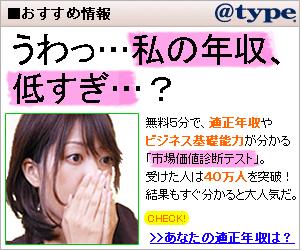
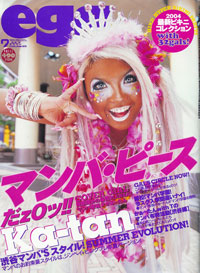


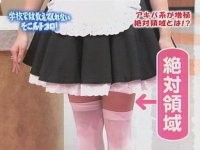
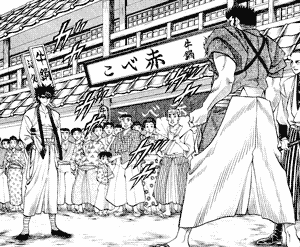
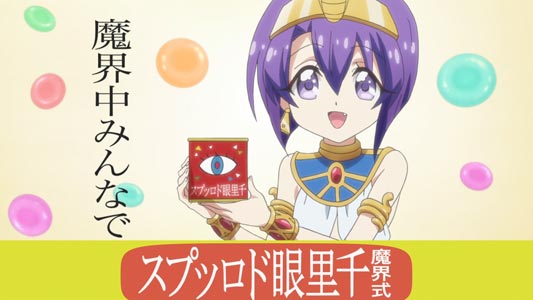
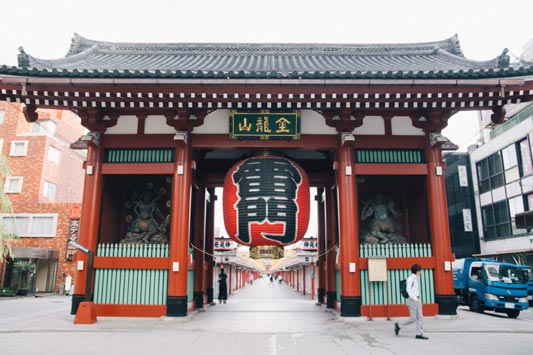
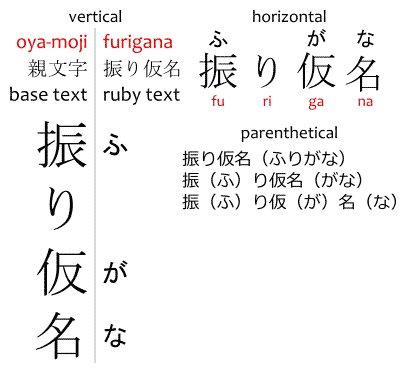
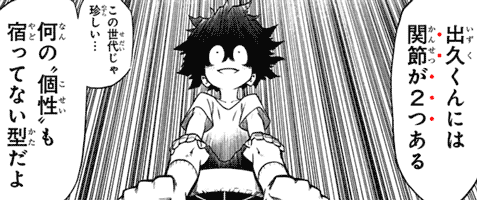
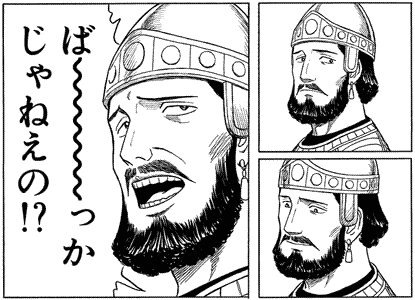
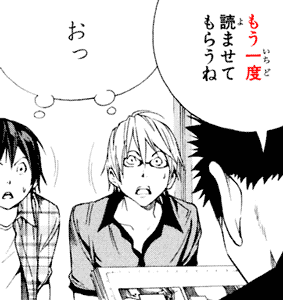
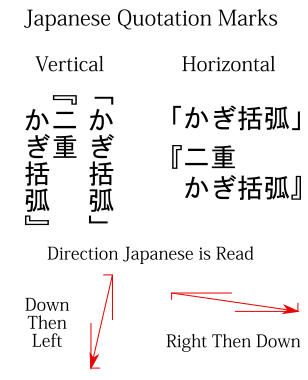
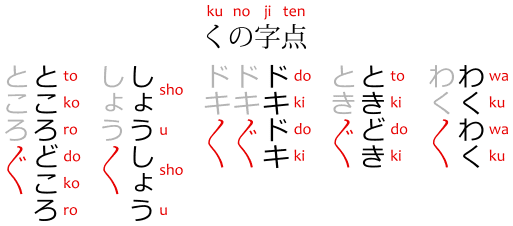
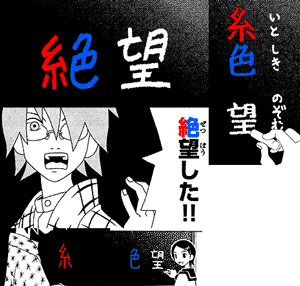
how do I write Shibui in janenese vertically?
ReplyDelete渋
Deleteい
Awesome article, thank you!
ReplyDeleteThis is different than how I learned why some things were right to left. When writing prominent titles, headings, and signs, it is still in the top-down right-to-left format, only that there is just 1 character in each column. It's not really written "horizontally" or "backwards", it just appears like that to those used to horizontal text. So that shop sign (akabeko) has 3 characters for 3 columns, 1 in each. Japanese navy ships in WW2 also were named like this. e.g. Shimakaze has 4 columns and 4 characters, but reads horizontally left-to-right as ze-ka-ma-shi.
ReplyDeleteThanks, great article
ReplyDeleteThank you, I'm just startig to learn Japenese and i wanted to know which form was correct. Now I know, thanks to you. Straight forward exlanation, with little backgroun, just the way I like it!
ReplyDelete